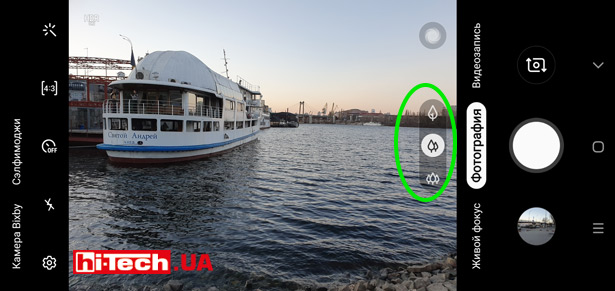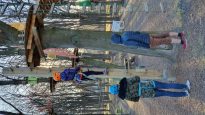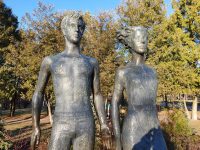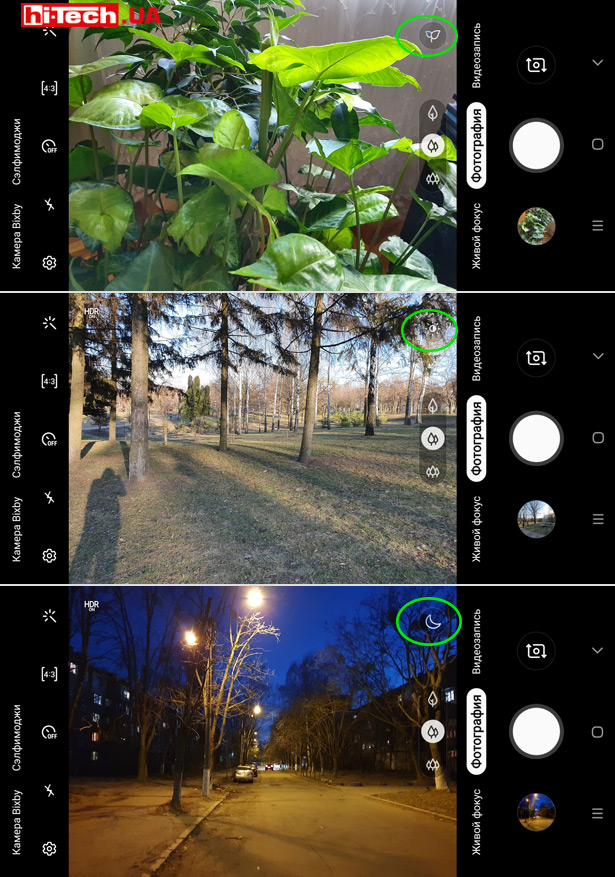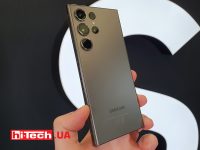Samsung Galaxy S10/S10+ triple camera test. Defensive play
05.04.19
Now there are three of them
If earlier in Samsung Galaxy S9+ The dual rear camera consisted of a main module (wide viewing angle) and an additional one with a narrower viewing angle (2x zoom), then in the new Samsung Galaxy S10/S10+ has added a third module with a “super-wide” viewing angle.
This decision, it must be said, is not unique. In 2018 there were already smartphones, for example LG V40 ThinQ, with the same camera configuration.
The Samsung Galaxy S10 line this year is represented by three models: Samsung Galaxy S10, Galaxy S10+ and Galaxy S10e.
The differences in the cameras of the S10 line models are shown on the official slide. As you can see, the Samsung Galaxy S10 and Galaxy S10+ have triple main cameras while in slightly. The simpler smartphone GalaxyS10e has a dual rear camera. And only the GalaxyS10+ also uses dual front cameras versus single cameras in the Galaxy S10 and S10e.
In the S10e smartphone, the manufacturer decided to install a main module identical to the S10 and S10+, and the additional one is not a telephoto camera, but a “super wide-angle” one.
Marking time
If we do not take the new third module, then when analyzing the characteristics it turns out that the sizes of matrices (sensors), their resolution and focal lengths and lens aperture in the new Galaxy S10 and S10+ have not changed compared to the previous generation Galaxy S9+.
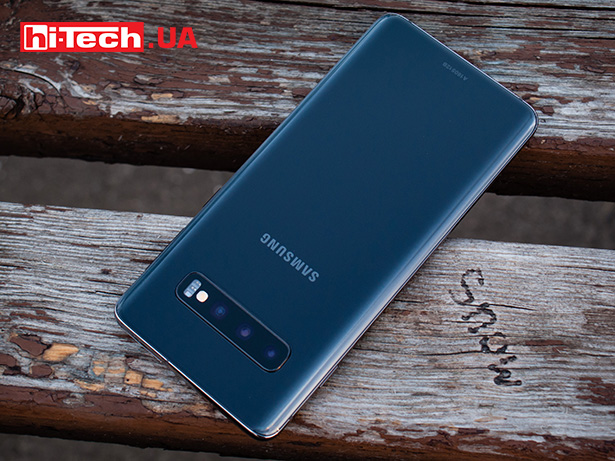
And that’s not very good. After all, a year ago, starting from P20 Pro, Huawei began installing larger 1/1.7-size sensors in its flagships. For comparison, the sensor in the main module of the Galaxy S10 and S10+ has standard size 1/2.55″. The larger the matrix, the easier it is, other things being equal, to achieve higher image quality. This primarily applies to shooting in conditions with limited lighting.
The telephoto camera performance of the Galaxy S10 and S10+ was also a bit disappointing. The equivalent focal length of its lens is only twice as long (52 mm versus 26 mm) as the focal length of the main camera.
This looked good a year or two ago, but today, with the Huawei P30 Pro’s telephoto camera having an equivalent focal length of 125mm (5x zoom), Samsung’s devices look more modest in this regard.
Highest class
Yes, Samsung in the new Galaxy S10/S10+, for the most part, “rides” on the baggage of developments that appeared in the previous generation of cameras Galaxy S9+, but this, in combination with some innovations, enough for the S10/S10+ smartphone cameras to be among the leaders in 2019 in terms of shooting capabilities and quality.
Once again I would like to note the simply excellent autofocus speed both during photo and video shooting.
Samsung has been completely fine with this for the last few years.
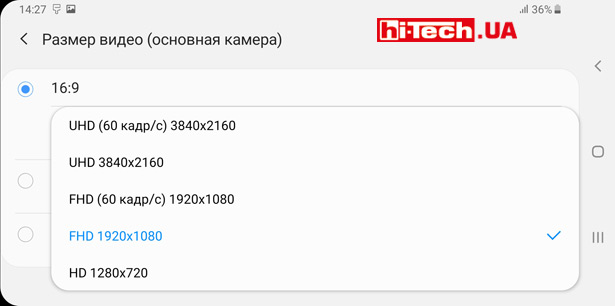
Smartphones can shoot 4K video at 60 fps. Recording modes with new HEVC codecs and recording in HDR10+ format are available.

The new products also retained the unique feature of the cameras of flagship smartphones Samsung – dual aperture. Depending on conditions, the main module may use a maximum aperture of f:1.5 or a closed f:2.4.
Why is this necessary, because it complicates the design and adds moving parts?
Here we repeat ourselves and note once again that when developing lenses, they always look for a compromise between many parameters (dimensions, weight, image quality, cost, etc.). A high lens aperture is good, because the matrix receives more light. But as the aperture increases, it becomes more and more difficult to make a lens as “sharp” and close-to-glare-proof; its dimensions grow, the complexity of the optical design increases, and the cost increases.
It turns out that with sufficient lighting, when noise is minimal, the camera sets the aperture value f: 2.4, providing higher image clarity, and when there is a lack of light, when noise and noise reduction systems begin to make a significant contribution to the final image, a more open aperture f is used :1.5, providing more light to the matrix.
Also, covering the aperture can be useful when shooting video to increase the shutter speed of each frame (the effect of shutter speed of frames when shooting video on the final picture is a separate topic for discussion).
Experiments with changing the aperture. On the left is a fragment of the edge of the frame at 100% zoom, taken with an aperture of F1.5. On the right, accordingly, is a fragment of the edge of the frame with 100% magnification, but with an aperture of F2.4.

Differences between the Samsung Galaxy S10, Galaxy S10+, and Galaxy S10e camerasComparison of the highlighted area of the frame at 100% magnification

Section of frame with 100% magnification (aperture F1.5)

Section of frame with 100% magnification (aperture F2.4)
- Original file with aperture F1.5
- Original file with aperture F2.4
As you can see, there is a slight advantage in clarity when using a closed aperture of F2.4. If you select areas in the center of the frame, the difference will be less noticeable.
The super slow-motion video mode has been slightly improved, when recording occurs at a speed of 960 fps.
Capturing the right moment has become easier, and the time period for deceleration can now be increased from 0.4 to 0.8 s. However, when the setting is set to 0.8 s, a note appears on the screen that the quality will be slightly reduced.
For our part, we note that this is simply a great feature. When experimenting, you can get very impressive results.
Look what we came up with when we played with this feature while shooting on the Samsung Galaxy S9+ a year ago.
The manufacturer separately noted a completely new level of image stabilization when shooting video and associates this with VDIS technology.
It’s a pity that we didn’t have a previous generation device at hand for comparison, but subjectively, the video stabilization in the new Galaxy S10/S10+ is simply amazing.
The front cameras in the entire trio of Galaxy S10e/S10/S10+ are new. These are 10-megapixel modules with an advanced Dual Pixel AF autofocus system and the ability to record 4K video.
Please note that only the Galaxy S10+ has a dual selfie camera. In addition to the 10-megapixel camera, there is an 8-megapixel camera installed, which is used exclusively for better performance of the background blur function.
Launch the Samsung Galaxy S10 camera
We carried out all shooting experiments using a Samsung Galaxy S10 smartphone. The main focus was on the rear triple camera setup. Once again, we note that the rear cameras of the S10 and S10+ are identical, and the slightly simpler S10e has one less camera (there is no telephoto module).

Given that the camera sensor has an aspect ratio of 4:3, when you set the maximum photo resolution on the elongated S10 screen, you will see black bars on the sides. By choosing a photo resolution with a different aspect ratio, you will get either reduced stripes or their complete absence.
We have always noted in Samsung smartphones the very successful idea of placing separate buttons for taking photos and starting videos next to each other. Now, to record video, you will first need to switch to a separate video recording mode. It has become not so convenient, in our opinion.
The idea of separate extensions that increase the functionality of the camera has long been abandoned. But if standard filters are not enough for you, you can download them additionally.
The order and set of shooting modes (“panorama”, “pro”, “live focus”, photo, “video recording”, etc.) can be changed.
There are special icons to select between the three rear cameras.
In the series of images you can see the differences in the focal lengths of the three cameras. On the left is the “super wide-angle” camera with a 13mm equivalent focal length, in the center is the wide-angle main camera with an equivalent focal length of 26mm, and on the right is the telephoto camera with an equivalent focal length of 52mm.
Modern smartphones already do a very good job of artificially blurring the background. This statement also applies to the Samsung Galaxy S10.
- No background blur
- Adding blur
- Zoom blur
By the way, in addition to regular blur, zoom blur and circular blur effects are now available. If desired, the object can also be highlighted by coloring the blurred area in black and white.
But, if desired, the camera can still be “confused” and the blur will be incorrect in places (see photo below).
By the way, high aperture in combination with, let’s say, not the smallest matrix, allows you to get real background blur with optics without any additional software effects. To do this, the subject being photographed must be at a relatively short distance from the camera.
The trending feature today is the use of artificial intelligence in cameras. This mainly manifests itself in the automatic detection of the scene being filmed (“plants”, “houses”, “night photography”, “food”, “child”, “dog”, etc.).
To activate such automatic detection of scenes, a separate button is displayed on the screen on which the found scene will be displayed (highlighted in green in the screenshots below).
Despite all the hype, in our opinion, this does not provide any particular benefit. The pictures only receive additional processing, which involves working with saturation, color balance, and contrast.
When shooting video, you can select an object in the frame and the camera will automatically focus on this object if it moves. The function is far from new for Samsung and, as before, is not available for all video recording modes.
Considering that the main camera is noticeably superior to the super wide-angle and telephoto cameras in terms of characteristics, its shooting quality will be higher. In good conditions, this will not be noticeable so clearly and will appear to a greater extent in low light conditions.
Therefore, if the viewing angle is not so critical for you, for better results we recommend that you focus on shooting with the main camera.
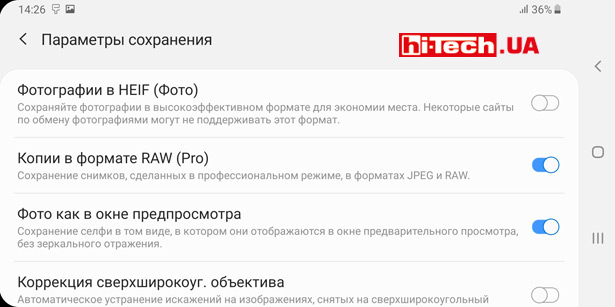
The “pro” mode, with the ability to manually adjust many shooting parameters, including control of shutter speed, aperture, and focus, remained virtually unchanged. But there is an important note. “Pro mode” is no longer available for video shooting, but for quite a long time this was a distinctive feature of the cameras of top Samsung smartphones. For the vast majority of users this is completely unimportant, but for video enthusiasts this change may matter.
Some examples of frames captured with the Samsung Galaxy S10 camera (all images were taken handheld in automatic mode)
Conclusions
Even now, when there are still many announcements ahead, we can confidently say that the Samsung Galaxy S10, along with the Galaxy S10+, will be one of the best smartphones of 2019 in terms of shooting quality and set of camera-related functions.
When shooting video, you will be provided with excellent autofocus, excellent image stabilization, and high-quality images. There are a number of interesting features designed for both hobbyists and enthusiasts.
Photography will also please you with high results.

Samsung Galaxy S10 в фирменном чехле LED Cove
But has Samsung put enough effort into its new smartphones when it comes to cameras?
Apart from improved stabilization and the addition of a third camera module, the Samsung Galaxy S10/S10+ are not very different from what we saw in the previous generation.
It turns out to be a kind of defensive game, but previously Samsung often set the pace itself.
Competitors today are very active and some have turned out to be much bolder than Samsung in terms of various experiments.
Here is an increase in the size of sensors, and the appearance of lenses with a periscope design, which allows you to realize a large lens focal length in a compact smartphone body.
Also today, the direction of computational photography is becoming increasingly relevant.
Seeing the development of this topic in Google and Huawei smartphones, when the final photo is obtained as a result of various deep processing processes, combining a series of frames, etc., we assumed that Samsung would place considerable emphasis on this. But this was not given any special attention in the Samsung Galaxy S10 line.
Read also:
- Testing the camera of the Samsung Galaxy S9+. Now with aperture control and 960 fps shooting
- Now double. Samsung Galaxy Note8 camera test
- We study the quality and shooting capabilities of the Samsung Galaxy S8 camera. Where is the progress?
- We are testing the cameras of Huawei P9, LG G5 se and Samsung Galaxy S7. Who takes better pictures?
- What can the Samsung Galaxy S7 camera do?
- A few words about the Samsung Galaxy S6 camera
Engineer of the Test Laboratory
Don't miss interesting news
Subscribe to our channels and read announcements of high-tech news, tes
Oppo A6 Pro smartphone review: ambitious

Creating new mid-range smartphones is no easy task. Manufacturers have to balance performance, camera capabilities, displays, and the overall cost impact of each component. How the new Oppo A6 Pro balances these factors is discussed in our review.
Editor’s Choice 2025. Best devices of the year by hi-tech.ua
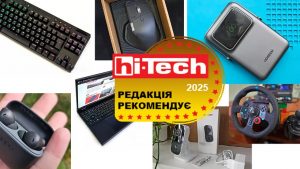
The best gaming laptops, mice for work, gaming keyboards, smartphones, and wireless headphones of 2025. Among them, we will highlight the most interesting ones and those that we can recommend buying.
Xiaomi Watch 5 is the first smartwatch with two medical sensors at once smart watches Xiaomi
Xiaomi Watch 5 will be the senior solution in the brand’s device line. The watch is built on the Qualcomm Snapdragon W5 platform
Lenovo Adaptable Keyboard can adapt the pressure of pressing keyboard Lenovo mouse
Lenovo uses an optical actuation mechanism in this model, which allows you to change the key travel and response characteristics.






